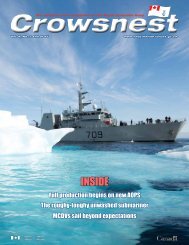Create successful ePaper yourself
Turn your PDF publications into a flip-book with our unique Google optimized e-Paper software.
Table 4: Overview <strong>of</strong> Major Indo-Pacific Navies <strong>and</strong> Coast Guards.<br />
China<br />
India<br />
South<br />
Korea<br />
Japan Indonesia Taiwan Vietnam Australia<br />
Navy 255,000 54,700 41,000 45,500 44,000 46,500 17,000 14,400<br />
[Reserves] [9,000] [1,100] [60,000] [8,300]<br />
Marines 10,000 2,000 27,000 20,000 15,000 27,000<br />
Submarines<br />
(SSBNs)<br />
5 203 X 204<br />
Submarines (SSNs) 5 1<br />
Submarines (SSKs) 53 13 12 16 2 2 3 6<br />
Aircraft Carrier 1 2<br />
Helicopter Carrier 2<br />
Destroyers 19 8 12 41 4<br />
Frigates 49 15 10 6 6 22 7 12<br />
Fast Attack -<br />
Missile<br />
86 75 12 43 14<br />
Patrol Craft 119 29 15 6 47 8 34 14<br />
Corvettes 8 24 25 22 8<br />
LPDs & LHDs 3 1 1 3 5 3<br />
MCMs 40 8 3 25 9 12 13 6<br />
Coast Guard n.a. 205 9,200 4,500 12,650 n.a. 17,000 n.a. n.a.<br />
Offshore Patrol<br />
Boats (>1,500<br />
tonnes)<br />
Coastal Patrol<br />
Boats<br />
22 12 5 39 6 7 1 1<br />
58 36 36 54 5 14 5 11<br />
Patrol Boats 504+ 37 9 296 125 117 28<br />
Source: Jane’s Fighting Ships 2014-2015. <strong>The</strong> data on coast guards is taken from International<br />
Institute <strong>of</strong> Strategic Studies, <strong>The</strong> Military Balance 2014 (London, February 2014).<br />
Geopolitical change always requires countries to engage in strategic recalibration. In <strong>the</strong><br />
Indo-Pacific, projection <strong>of</strong> power, deterring or coercing adversaries, conducting trade <strong>and</strong><br />
maintaining communications, largely take place over large expanses <strong>of</strong> water. This overtly<br />
maritime strategic region defines defence policies, diplomacy, <strong>and</strong> war planning <strong>of</strong> both local<br />
<strong>Power</strong>s <strong>and</strong> those that are more remote, like <strong>the</strong> US, who claim vital interests to be present in <strong>the</strong><br />
region. With <strong>the</strong> possible exceptions <strong>of</strong> war on <strong>the</strong> Korean peninsula <strong>and</strong> confrontations<br />
203 PLA(N) nuclear-powered ballistic missile submarines (SSBNs) will not be operational until <strong>the</strong> JL-2 missile<br />
enters service. See James R. Clapper, Director <strong>of</strong> National Intelligence, Worldwide Threat Assessment <strong>of</strong> <strong>the</strong><br />
US Intelligence Community, presented to <strong>the</strong> Senate Armed Services Committee, 26 February 2015, p. 7.<br />
204 India has built two Arihant-class SSBNs. <strong>The</strong> first is undergoing sea trials, while <strong>the</strong> second was<br />
launched in 2014 <strong>and</strong> is likely to be commissioned in 2015.<br />
205 <strong>The</strong> platform numbers for China in Table Six include both <strong>the</strong> Chinese Coast Guard <strong>and</strong> China’s<br />
<strong>Maritime</strong> Safety Administration.<br />
DRDC-RDDC-2016-R085 43




